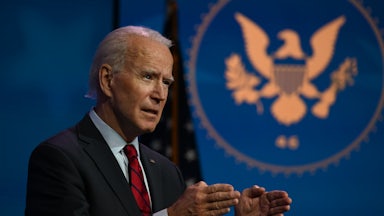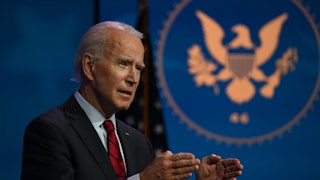One of the more puzzling developments in states’ rights conservatism has been the combination of don’t-tread-on-me militancy with a determination to keep sucking on the federal teat. This untidy jumble of defiance and dependency will be instantly recognizable to parents of teenagers and readers of Anthony E. Wolf’s brilliantly titled 1992 teen parenting manual, Get Out of My Life, but First Could You Drive Me & Cheryl to the Mall?
The latest instance of this contradictory strain arrives courtesy of Ohio’s attorney general, Dave Yost. Yost, you may recall, filed a brief to the Supreme Court after the November election urging it to throw out ballots in Pennsylvania. Not content to tell the federal government to mind its own beeswax, Ohio sought to settle a dispute between Pennsylvania’s Republican-controlled state legislature and its state Supreme Court about the proper deadline for mail-in ballots. The high court told Yost, along with the Pennsylvania legislators, to get lost.
Yost’s new lawsuit, Ohio v. Yellen, asserts that Ohio fully intends to help itself to $5.5 billion made available under the new Covid-19 relief law. (Drive me & Cheryl to the mall!) But Ohio won’t comply, Yost says, with a condition laid down in the statute—a “tax mandate” barring states that accept the aid from offsetting it with a tax cut. Whether Ohio cuts its taxes or not, Yost’s lawsuit sputters, is none of the federal government’s damned business. (Get out of my life!)
Yost’s glorified legal tantrum is no one-off. Twenty-one other Republican state attorneys general are threatening to file similar lawsuits, and 39 House Republicans wrote Treasury Secretary Janet Yellen Wednesday demanding answers about this encroachment on state sovereignty. The party that used to intone that rights must be balanced against responsibilities is now affirming states’ constitutional right to ignore that whole irksome “responsibilities” part. Like the bratty kid in a classic 1950s TV commercial, the GOP refuses to decide between wearing its cowboy hat and eating its morning cereal. I want my cowboy hat! it wails. I want my Maypo!
The attorneys’ general letter cited two Supreme Court cases in their defense. The first was 1987’s South Dakota v. Dole. South Dakota was a weird choice because in that case, the high court upheld the federal government, in the person of Transportation Secretary Elizabeth Dole placing (at the direction of Congress) conditions on state receipt of highway aid.* Interestingly, the condition concerned actual teenagers. (Get out of my life!) To receive the highway aid in full, a state had to raise its drinking age to 21. The court ruled that condition constitutional. The very conservative Chief Justice William Rehnquist wrote the opinion, and the even more conservative Antonin Scalia joined the majority.
The second case the attorneys general cited was 2012’s National Federation of Independent Businesses et al. v. Sebelius. This case was better suited to their argument, because it advanced the bratty new version of states’ rights conservatism. NFIB is remembered as the decision in which Chief Justice John Roberts, writing for the majority, betrayed partisan Republicans by upholding Obamacare. But Roberts also struck down a condition that Obamacare placed on states’ continued participation in Medicaid, the federal-state health insurance program for low-income people.
To continue receiving federal Medicaid dollars, Congress said, states must extend Medicaid coverage to adults with incomes up to, effectively, 138 percent of the poverty line. This was entirely reasonable. The feds already bankrolled, on average, 57 percent of state spending on Medicaid; though the proportions varied from state to state, by law the federal portion could never fall below 50 percent. Surely that gave Congress considerable say in how the states managed the program.
Under Obamacare, the federal government bankrolled not 50 percent of the Medicaid expansion, and not 57 percent, but at least 90 percent (and under some circumstances 100 percent). For the states, this was very, very close to free money. Nevertheless, 26 states sued. (They’re the “et al.” in NFIB.)
In his decision, Roberts didn’t seem to care that the federal government would pay for nearly all the expansion in Medicaid eligibility. The states, he said, were so reliant on Medicaid funding—typically more than 10 percent of a state’s entire budget—that any threat to discontinue it constituted “economic dragooning that leaves the States with no real option but to acquiesce in the Medicaid expansion.” Never mind that Arizona, the last state to adopt Medicaid, had for nearly 20 years put its states’ rights’ money where its mouth was by refusing to participate in Medicaid. In short: Get out of my life! Drive me and Cheryl to the mall! I want my cowboy hat! I want my Maypo!
Ohio v. Yellen applies Roberts’s “economic dragooning” argument to state Covid relief. The $5.5 billion that Ohio is in a position to receive, Yost contends, fills such a large and urgent need in Ohio’s budget that Ohio has no real choice except to take the funds, especially while attempting to respond to the economic instability wrought by the Covid-19 pandemic.
That’s pretty rich, coming from a partisan Republican like Yost. Not a single Republican voted for the Covid-19 relief bill in either the House or the Senate. Senate Minority Leader Mitch McConnell tried to cut state aid from the bill altogether. Yet now Yost argues that this aid is so vitally necessary that any condition placed on Ohio’s receipt of these funds is unspeakably cruel. If that’s true, why doesn’t Ohio’s Republican Governor Mike DeWine demand that the Senate expel Ohio’s Republican Senator Rob Portman, who voted not to furnish any aid at all? Or that the House expel the 39 Republican members demanding answers from Yellen? None of them voted for this urgently needed state aid, either.
As Roberts noted in his majority opinion in NFIB, Obamacare’s Medicaid mandate threatened more than 10 percent of state budgets. It therefore had to go. Yost argues in his suit that the Covid tax mandate threatens 8.6 percent of state budgets. It therefore has to go. An important question for political scientists is how much lower that percentage must fall before today’s conservatives concede that the state governments they revere are able to exercise any free will at all.
* This article originally misstated the year in which a Supreme Court case was decided.








